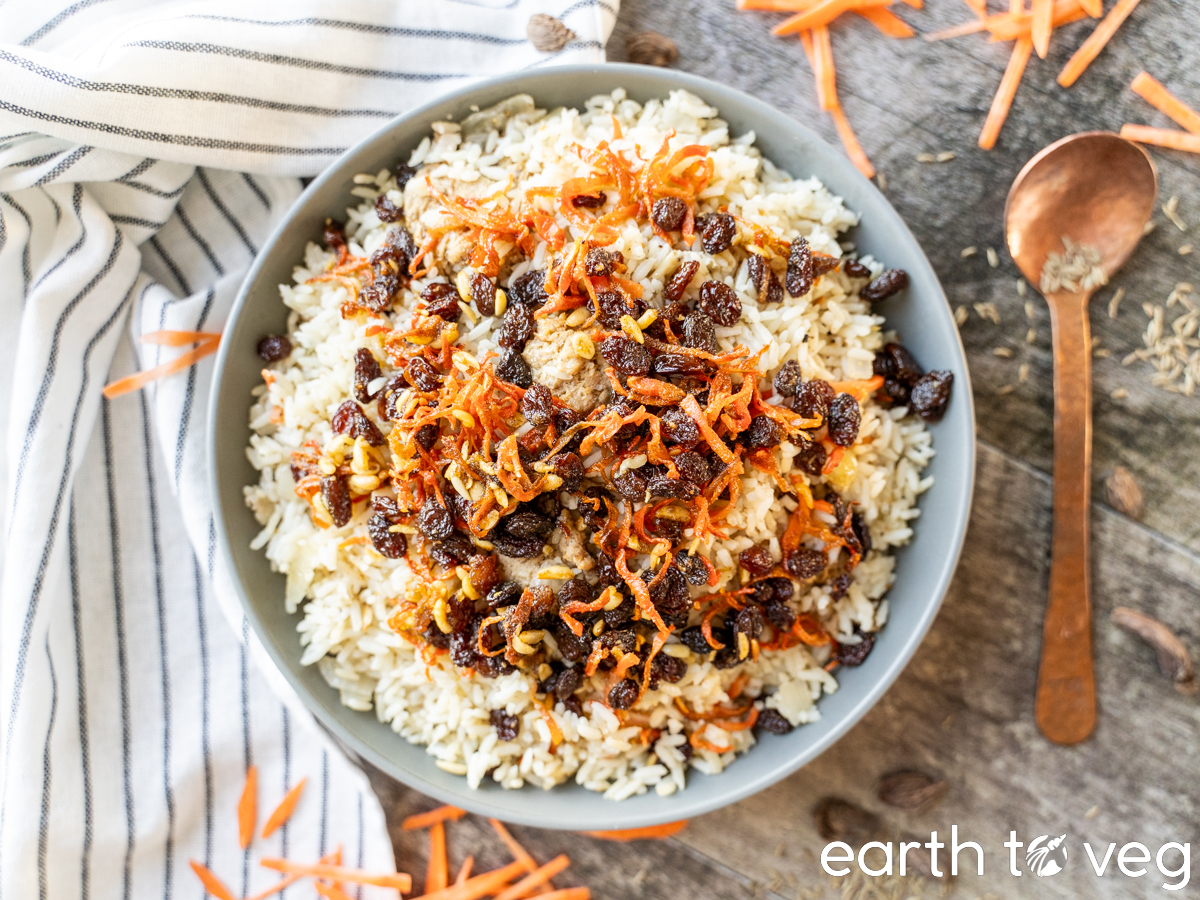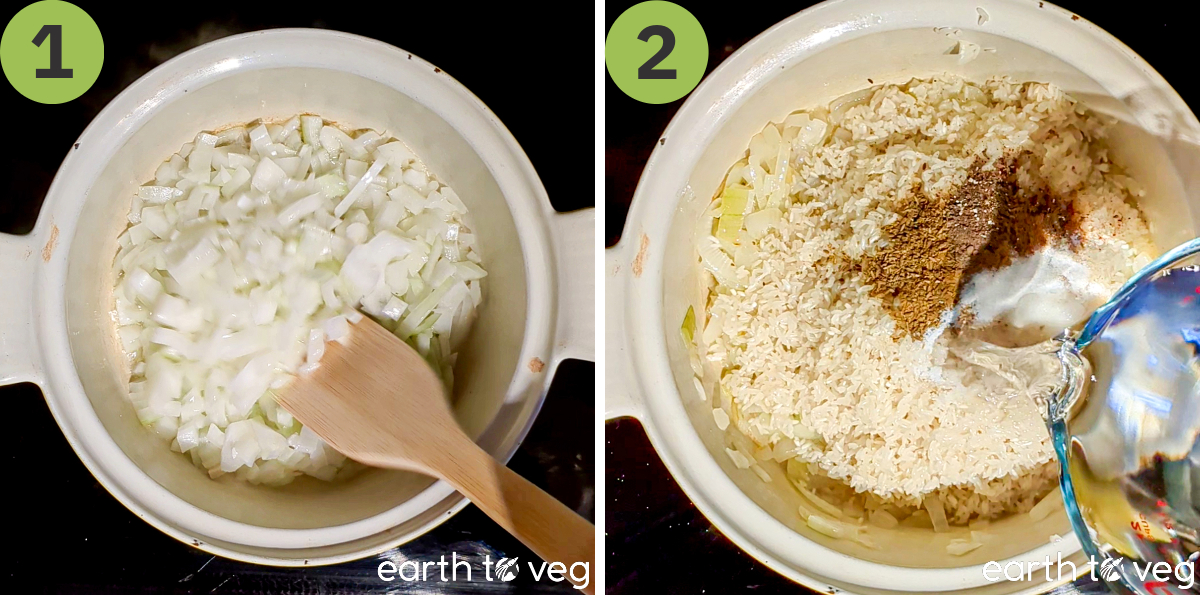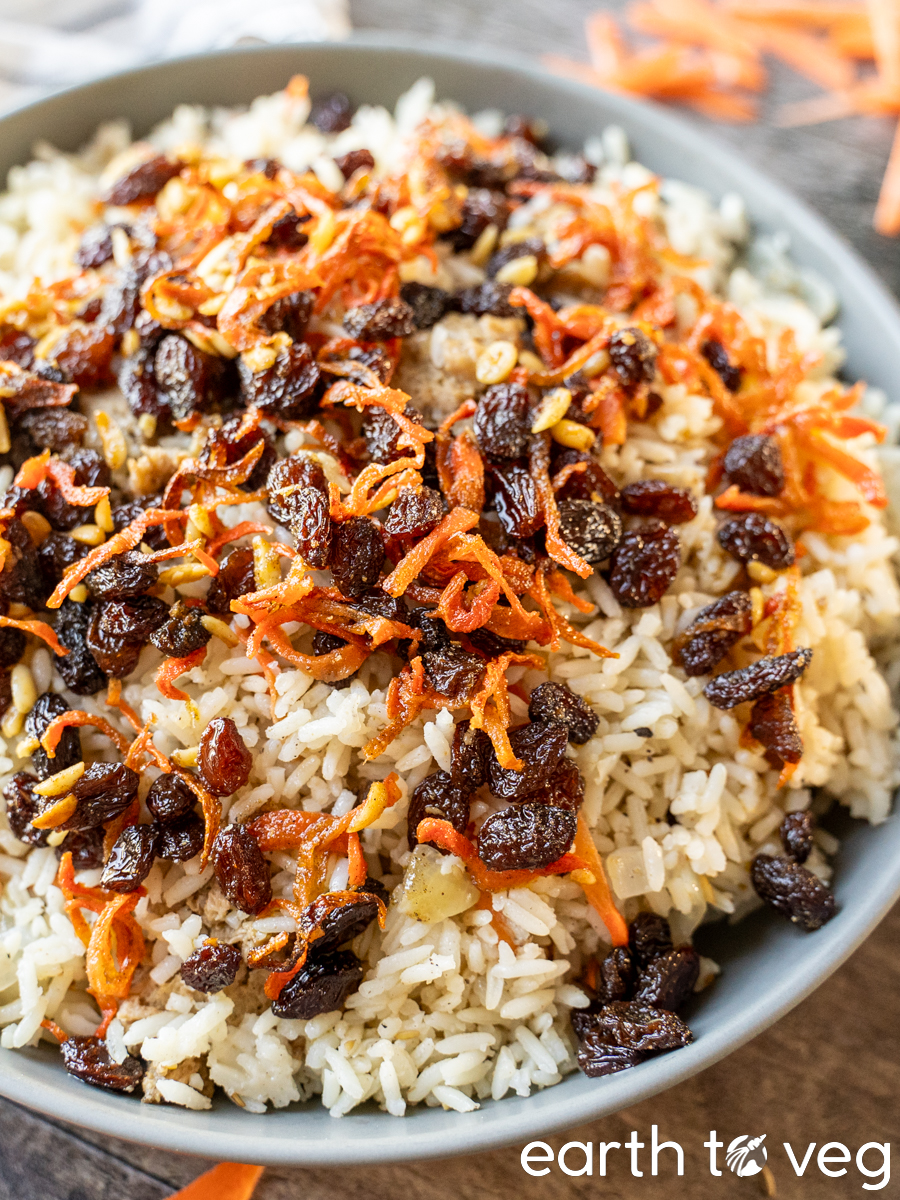Kabuli Pulao is Afghanistan’s ultimate celebration dish. The spice-infused, richly fragrant rice is traditionally made with lamb and reserved for special occasions. This vegetarian and vegan-friendly version of Kabuli Pulao is so good, it’s a cause for celebration all on its own! Make it on the stove or in the Instant Pot.

History & Origins
I learned about Kabuli Pulao while reading Parwana, a cookbook of Afghan recipes. Also known as Qabili Palaw, it’s “Afghanistan’s national dish.” You can find it on the menu of just about any Afghan restaurant.
Originally, the recipe was named for Afghanistan’s capital city of Kabul. It used to be that only wealthy families could afford this dish. High quality carrots, raisins, and nuts made this an expensive luxury in earlier times, not to mention how time-consuming it is to julienne carrots and sliver nuts by hand. But as Kabuli pulao became accessible to more people, it took on a new name: Qabili, from the Dari Persian word for “well accomplished.” Indeed, the skill of an Afghan cook is assessed on the quality of their Qabili palaw.
Luckily, this vegan version is less time-consuming, and it comes together mostly in one pot!
Types of Afghan Rice
Like many Asian countries, Afghanistan loves its rice. Afghan rice dishes can be steamed on the stove or baked in the oven. There are three main types of rice dishes in Afghan cuisine:
- Challaw (aka chalow): White basmati rice, prepared quite simply with oil and minimal spices, usually served as a side.
- Pulao (aka pilau or palaw): An elaborate and complex dish, also made with basmati, but packed with more ingredients. Often the centerpiece of a big meal. Kabuli pilau is the most well-known, to the point where it’s simply called “Afghan rice” on some menus.
- Sholah (aka shola): A creamy, sticky rice made with short- or medium-grain rice, with a consistency closer to risotto.
Palaw’s Central Asian Cousins
The first time I tried Kabuli Palaw, I was struck by how similar it tasted to a dish I remembered from my childhood: Polo. Polo is one of the Uyghur recipes my mom learned in Xinjiang. She only made it a couple of times while I was growing up, but I remember it well because it was one of the few meals we got to eat with our hands.
It turns out, this similarity is not surprising because palaw and polo have the same Central Asian origins. In fact, neighbouring countries such as Pakistan, Uzbekistan, Turkmenistan, and Tajikistan have similar dishes too. They all use rice and lamb as the primary ingredients, along with carrots, onion, cumin, and raisins.
- To make Uzbek Plov first requires cooking of a zirvak, a rich stew of vegetables and meat, which is layered underneath the rice. Often contains red chili peppers and whole heads of garlic.
- Turkmen Palow uses less spices, giving it a simpler flavour. The carrots are cooked together with the rice instead of as a separate topping, making it a one-pot recipe. Like the Uzbek version, it may be served with whole garlic.
- Tajik Oshi Palav (палав) includes chickpeas in addition to the other usual ingredients.
- Uyghur Polo is from Xinjiang but is also popular in the rest of China. It’s known in Mandarin as Shouzhuafan (手抓饭), meaning “hand grab rice.” That’s the way it was consumed historically, though nowadays many Uyghurs eat it with a spoon. Because of how common it’s become throughout China, you may see versions of this recipe containing ginger, soy sauce, and even Sichuan pepper, though none of these are found in traditional polo. Instead of basmati, the Uyghur version uses short-grain or medium-grain rice.
- Pakistan’s northwestern province of Khyber Pakhtunkhwa is majority Pashtun, sharing the same culture and cuisine of their Afghan neighbours, so you’ll often see this dish in those parts of the country as well.
- A rather different version of this recipe has even made it to Saudi Arabia, where it is known as Bukhari Rice (رز بخاري or Ruz al Bukhari). It is more commonly made with chicken and has the addition of tomato sauce.
What You’ll Need

A few important notes on some of the ingredients used in this Vegan Kabuli Palaw recipe:
Oil: Okay, let’s face it, this recipe uses a lot of oil. It’s important for the dish’s distinctive rich flavour! If you are really health conscious though, you can reduce the oil by half for a lighter dish.
Onion: Important to use yellow onion or white onion here. Red onion has too strong of a taste and the flavour clashes with the rest of the spiced rice.
Basmati Rice: The traditional rice for Kabuli palaw is basmati rice. If you don’t have it, use another long-grain white rice.
Cumin: Double the cumin for a more heavily-spiced rice.
Cardamom: I use black cardamom in the rice and green cardamom in the topping. If you don’t have ground black cardamom, you can use green cardamom instead for both rice and topping.
Vegan “Lamb” Chunks: For a more authentic taste, I added a handful of vegan lamb chunks from my local vegetarian specialty store. But feel free to leave it out or use a meaty alternative like Beyond Steak or Chick’n Chunks.
Carrot: Carrots are julienned into matchsticks, then fried in oil for the rice topping. They become very sweet and slightly crispy. Even my boyfriend, who normally hates carrots, is happy to eat them when I make this palaw.
Sultanas or Raisins: Adds a juicy burst of sweet and tart flavour. It’s not uncommon to find raisins in rice throughout the Middle East and Asia. Trust me, it’s delicious!
Almonds and Pistachios: Almonds and pistachios are used in the topping for kabuli palaw. They’re slivered (peeled and sliced into thin strips). You can buy slivered almonds and slivered pistachios which are pretty convenient. But since you only need a little bit of each, it’s not too much work to peel and chop them up yourself. Here’s a video tutorial on how to make slivered almonds and pistachios.
For a full list of ingredients and quantities, refer to the recipe card at the bottom of this post.
The Kafgeer
To make palaw, most Afghan households use a special tool called a kafgeer. It’s a large, shallow spoon that can be used to stir the rice while cooking and to serve it when done.
Unfortunately I don’t have a kafgeer at home. I use my old wooden spoon and a rice paddle, which work just fine!
Step-by-Step Process
Instructions below are for stovetop. For Instant Pot instructions, scroll down to the recipe card.
Start by making the pulao rice:

Step 1: Heat oil in a large Dutch oven or stockpot on medium-high heat. Add diced onions and sauté, stirring occasionally.
Step 2: When the onion turns translucent add rice, salt, cumin, cardamom, and water. Cover the pot and let it come to a boil.

Step 3: Give everything a stir to lift any rice that’s stuck to the bottom. Add vegan lamb to the center of the pot. Cover, turn down the heat, and gently simmer.
Step 4: After 15 minutes, remove from heat and set aside, covered, for another 10 minutes. Meanwhile, prepare the toppings.
Next, prepare the toppings:

Step 5: Fry the carrots, sultanas, almonds, and pistachios in oil until most of the oil is absorbed.
Step 6: Mix in the sugar and cardamom, then pour the mixture (including excess oil) over the rice.
Make Ahead & Storage Tips
Fridge: Store kabuli pulao in the fridge in an airtight container for up to five days.
Freezer: Kabuli pulao freezes well. I portion it into individual-serving ziploc bags and lay them flat in the freezer. Super space efficient! When you want to eat, just take out a bag and thaw it in the fridge overnight. Or plop it out onto a microwave and hit the defrost button.
Reheat: Microwave until heated through.
More Flavourful Rice Recipes

Recipe Card
Did you make this recipe? Please consider leaving a rating below to let me know how you liked it.
You can also take a picture and tag me on Instagram @earthtoveg, I will shout you out in my Stories!

Vegetarian Kabuli Pulao (Afghan Rice)
Use Imperial/Metric buttons below to toggle between volume vs weight measurements. I recommend weighing out your ingredients for best results.
Equipment
- Dutch oven or heavy-bottomed stock pot (for making the pulao rice; a 4-quart pot is the perfect size for 1 batch of this recipe)
- Small skillet (for making the toppings; I use a Lodge 6.5-inch cast iron pan)
- Wooden spatula
Ingredients
Pulao
- ¼ cup oil
- 1 large yellow onion, diced
- 2 cups dry basmati rice
- 2 tsp fine sea salt or 3 tsp kosher salt
- 2 tsp ground cumin see Note 1
- 1 tsp ground black cardamom see Note 2
- 3 to 4 cups water use 3 cups (720g) for Instant Pot, or 4 cups (960g) for stovetop method
- 2 cups vegan "lamb" or "beef" chunks *optional; see Note 3
Toppings
- 3 tbsp oil
- 1 carrot
- ½ cup sultanas or raisins
- 1 tbsp slivered almonds
- 1 tbsp slivered pistachios
- 1 tsp sugar
- 1 tsp ground green cardamom
Instructions
For the Pulao Rice
- Rinse and drain the basmati rice.
- Heat 1/4 cup of oil in a large Dutch oven or stockpot on medium-high heat. Add diced onions and sauté, stirring occasionally. (Instant Pot: Use the Sauté setting and set it to More mode. Once the display reads HOT, add 1/4 cup oil followed by the diced onions.)
- When the onion turns translucent (5–10 minutes), add rice, 2 tsp salt, 2 tsp cumin, 1 tsp cardamom, and 4 cups water, in that order. (Instant Pot: Use just 3 cups of water and also add vegan lamb at this stage, if using.)
- Cover the pot and let it come to a boil. (Instant Pot: Use the Pressure Cook setting on High Pressure for 3 minutes.)
- Once boiling, give everything a stir to ensure no rice grains have stuck to the bottom. Add the vegan lamb to the center of the pot. Cover again, turn the heat down to low, and continue to cook for 15 minutes.
- After 15 minutes, remove from heat and set aside, covered, for another 10 minutes. Meanwhile, prepare the toppings. (Instant Pot: Once the Instant Pot turns off, allow the pressure to naturally release for 10 minutes.)
For the Toppings
- Julienne the carrots into fine matchsticks and slice the almonds and pistachios into slivers.
- In a small saucepan on medium-high heat, fry the carrots, sultanas, almonds, and pistachios in 3 tbsp of oil until most of the oil is absorbed (3–5 minutes).
- Mix in the sugar and cardamom, then pour the mixture (including excess oil) evenly over the rice.

This reminds me of the rice at my local Yemeni restaurant. Can’t get enough!
I’m not surprised that it’s a popular rice flavour combo and that other cuisines have something similar!